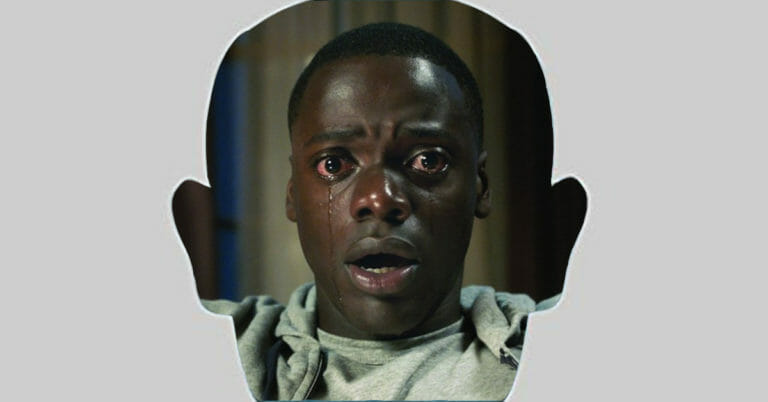By Travis Maiuro · April 24, 2018

When you think of the films that influenced Jordan Peele’s Academy Award-winning Get Out, coming to mind are The Stepford Wives, Rosemary’s Baby, and Guess Who’s Coming to Dinner. Spike Jonze and Charlie Kaufman’s Being John Malkovich typically doesn’t make the list. But Malkovich (an Oscar-nominated script itself) and Get Out are more alike than one would think — and it’s not just because of a Catherine Keener connection.

Think about it: Get Out is about, among other things, a cult of predominantly older white people kidnapping young black people to transplant their own brains into their bodies, as a way to stay young and gain the talent and skills they can only dream about having.
Being John Malkovich is about a portal that allows entry into the body of the actor John Malkovich. Using this portal to enter the host body when “ripe,” one can greatly increase one’s lifespan. Malkovich’s body is being prepped by a group of older people to be used as the next host body so they can live longer.

Granted, they’re not so similar that one could be a remake of the other. But still, both concepts flirt with the theme of wanting to be someone else, in very bizarre ways. Both could be thrown into the subgenre of lo-fi sci-fi — sci-fi that feels very grounded and real, in the vein of magical realism. Of course, Get Out isn’t shy about embracing its genre of thriller/horror but there’s still room to consider it lo-fi sci-fi. Malkovich’s concept could easily become a horror film, with just a couple small tweaks in tone and story. Think about it: a portal that you don’t know about allows total strangers to enter your body and control it… that is a horror film!

It must be said, however, that overall, the major themes tackled in each film are very different. Yes, they both focus on people wanting to be someone else — but for very different reasons. Being John Malkovich is about self-absorption and misery — wanting to be someone else because of our own shitty life choices. Our protagonist, Craig, is a man so miserable with his own life that his talent as a puppeteer is his only solace — it’s his escape, his chance to live, temporarily, as someone else. So when he finds a portal into the actor John Malkovich’s body, his puppeteering dreams of starting life anew are finally realized. Get Out, of course, explores racial tension, and how white liberals can be just as racist as the outwardly. In Get Out, wanting to be someone else — in this case, wanting the black body for personal/selfish reasons — is akin to the slave trade. These white liberals think their admiration (if you want to call it that) of the black body absolves them of racism. But in reality, it’s no different than selling and trading African bodies and souls, stolen from their home continent.

That being said, let’s return to the horror film aspect. Because under the lens of viewing Being John Malkovich as a horror film (without the jump-scares, let’s say), it becomes much easier to see the similarities between that film and Get Out and therefore easier to compare the two scripts. To view Being John Malkovich as a horror film, we have to shift the focus to Malkovich himself and see the story through his eyes.
When someone — whether it’s Craig or Maxine or Lotte — takes over Malkovich’s body by way of the portal, Malkovich falls into a helpless void similar to what Peele created in Get Out with the “sunken place.” With the tinkle of a spoon against a teacup, Chris sinks in Get Out, unable to break free of the smothering darkness. And the unfortunate ones who have been taken over and have had the majority of their brains replaced with the brains of old white people, the sunken place is even worse — like Malkovich, they’re trapped in a void, helpless to fight back, forced to watch as a stranger controls their movements, actions, and desires.

And even with the focus off of Malkovich and on the film’s rightful protagonist, Craig, there’s a nightmarish, horror-like quality to the way his life unravels after discovering the portal. Losing his wife and the woman he (pathetically and creepily) desires — to each other, mind you — is pretty scary. But not as scary as the way the script ends, with Craig trapped inside the young body of Maxine and Lotte’s daughter (who happened to be the next portal), forced to watch them live a happy life together.

Get Out’s Chris is decidedly the more sympathetic protagonist, compared to the, for lack of a better word, asshole that is Craig in Being John Malkovich. But that’s the way it’s supposed to be. Craig isn’t supposed to be likable, whereas Chris is. Chris is essentially the protagonist John Malkovich would have been in Being John Malkovich if roles were reversed. (Certainly, Chris’s predicament is incredibly more dire than the Malkovich character, but you get the point.) If the white people were the protagonists of Get Out, in particular, the character of Jim Hudson — the man who wants to take Chris’s body — then the similarities between the two films would be that more evident.

It’s funny — Chris’s likability allows us to root for him and to, in a sense, put ourselves in his shoes, to use him as a vessel into the world of the story. We want him to get out because we want to get out and escape this world, as well. We become Chris — though without the need of the sunken place or brain transplanting. Not to get too artsy-fartsy/philosophical about it, but both movies and their themes can be seen as a metaphor for movie watching. Being John Malkovich even goes as far as putting us in the body of an actor no stranger to the screen. With movies (when they work, that is), we are transported into the lives and minds of characters that aren’t always like us. Movies are a lesson in empathy — the films Get Out and Being John Malkovich included.

Both films come to the same conclusion: wanting to be someone other than yourself is bad. No other way to put it, really. And the way they do this is, ironically, by allowing us to be someone else for an hour and forty to fifty minutes. Like I said, while the two films aren’t so similar to be remakes of one another, there is a kinship present between the two — enough that would make for a great double feature one Sunday afternoon. The “Get Out of Malkovich Double Bill”. Sounds amazing, doesn’t it? I recommend it.

And don’t forget about ScreenCraft’s Horror Screenplay Contest that’s happening right now. Early deadline is May 3rd.
 Travis Maiuro previously taught the craft of writing while pursuing his MFA in Screenwriting from the University of Texas at Austin. He also writes about movies here.
Travis Maiuro previously taught the craft of writing while pursuing his MFA in Screenwriting from the University of Texas at Austin. He also writes about movies here.
Photo credit: Gramercy and Universal
For all the latest from The Script Lab, be sure to follow us on Twitter, Facebook, and Instagram.